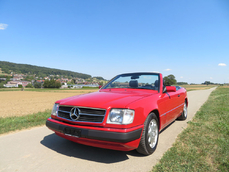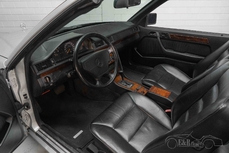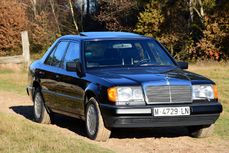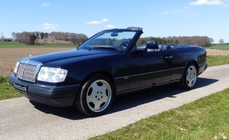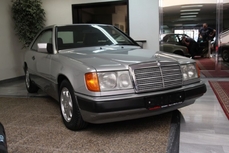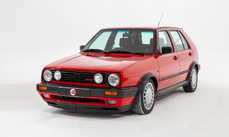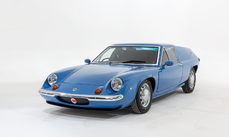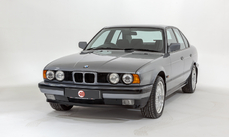Mercedes-Benz 300 w124 1992
Allgemeine Beschreibung :
Model History
W124 was the Mercedes-Benz internal chassis designation for the 1984-1996 version of the Mercedes-Benz E-Class, and was as the first generation to be officially referred to as E-Class. The W124 models replaced the W123 models after 1984 and were succeeded by the W210 E-Class after 1995.
Much of the 124's engineering and many of its features were advanced automotive technology at its introduction, incorporating innovations that have been adopted throughout the industry. It had one of the lowest drag coefficients of any vehicle of the time due to its aerodynamic body, that included plastic molding for the undercarriage to streamline airflow beneath the car, thus reducing fuel consumption and wind noise. It had a single windscreen wiper that had an eccentric mechanism at its base that extended the wiper's reach to the top corners of the windscreen (more than if it had traveled in a simple arc). The saloon, coupes, and convertibles had optional rear headrests that would fold down remotely to improve rearward visibility when required. This feature was not available for the T-model because of its specific layout (no space to store the retractable headrests), but the estate serially came with a "neighbour-friendly" rear door that was pulled in the shut-position silently and automatically by a sensor-controlled servomotor. This allowed the use of a tighter fitting rear gate, minimizing the cabin noise in the T-model, sometimes an area of concern for estate cars.
With the exception of the 200, fuel injection was standard and the engines incorporated features that maximised performance. The most notable feature was the addition of an oxygen sensor in the exhaust system, which, in conjunction with a semi-electronic fuel injection system, could make the engine run more efficiently. This improved fuel consumption while simultaneously meeting stricter emission regulations. Mercedes-Benz's four-wheel drive system, the 4Matic was first introduced on the W124 in 1987.
The estate cars (chassis designation S124) came in five or seven-seat variants, the seven-seater having a rear-facing bench seat that folded flush into the luggage compartment floor. The S124 estate continued in production alongside the new W210 until the S210 estate launched more than a year later.
Equipment
Smoke Silver Metallic paintwork, Beige chequered cloth upholstery, 4-Speed automatic transmission, 15-Hole alloy wheels, Electric tilt/slide sunroof, Leather steering wheel and gear selector knob, Front central armrest, Burr walnut interior trim, Electric windows front and rear, Heat-insulating glass all round, Headlamp wash/wipe, Power assisted steering, Blaupunkt cassette radio, Rearward facing seats, Outside temperature gauge, Retractable dog guard, Retractable rear load cover, Mudflaps front and rear.
Exterior
With only 111k miles covered in the last 29 years, this charming W124 estate remains in fine order throughout. The Smoke Silver paintwork retains a deep metallic shine and, while not entirely blemish-free, still presents to a great standard overall. With its period-correct amber indicators and lower panels in contrasting Shell Grey, the car retains that classic two-tone Mercedes look so typical of the era. All the lights are clear and free from any moisture damage, and the chrome throughout also presents really well with a deep shine to report on close inspection. Additionally, the underside is very solid having never required any welding repairs.
VIEWINGS WELCOME BY APPOINTMENT ONLY /// ADDITIONAL PHOTOS AVAILABLE UPON REQUEST
Interior
The beige cloth remains in excellent condition showing no signs of major use. The seat upholstery is free from any of the usual sagging or worn bolsters, and the front central armrest is also without any damage. The well-appointed cabin is laced with burr walnut trim and features an electric sunroof, electric windows, a Blaupunkt cassette radio, and comfortable seating for seven people. All the switchgear is pleasingly solid to operate and commonly worn items such as the steering wheel and gear knob still retain a nice textured feel. At the rear of the car the vast boot space houses the optional third row bench seat. When not in use, this row of seats folds down into the recess that otherwise serves as a footwell.
ENGINE & TRANSMISSION
As a 300TE ‘24’ this top-of-the-line E-Class estate was factory-specified with the desirable 24v 3-litre straight-six. The engine bay remains clean and tidy with no signs of any corrosion or previous poor repair. Out on the road this 24v example is a real joy to drive, offering effortlessly smooth and refined performance whatever the pace.
The car has just returned from our trusted classic car specialists following a full vehicle health check and service. A couple of minor electrical items were picked up on inspection and of course these have now been rectified, the total for this work costing in excess of £1,200. A fresh MOT was also carried out for the new keeper’s peace of mind, which is valid until August 2022.
WHEELS, TYRES & BRAKES
The original 15-hole alloys look great all round with only some expected age-related wear and light curb marking to report to each wheel. They are shod in a matching set of Michelin tyres, each one with plenty of tread left. The brakes have also been checked and remain in fine operational condition, stopping the car quickly and in a straight line.
History File
First registered in Jersey in January 1992, this 24v 300TE has now driven just 111k miles from new. The accompanying History File contains the original service booklet (stamped up to 90k miles), owner’s manuals and Blaupunkt operating instructions. The Jersey registration document shows the car to have had only 3 former keepers including 2 motor traders, meaning just 2 private owners in total.
Since arriving with us the Mercedes has received over £1,200 of preparation to include a full mechanical inspection, service, and MOT. Having only recently been imported from Jersey with all relevant taxes paid on arrival, the car will come fully UK-registered ready for its next custodian. All in all, a fine example of the coveted W124 Mercedes, ready to be driven and enjoyed for many years to come.
http://www.4starclassics.com/for-sale/mercedes-w124-300te-24-for-sale/
1992 Mercedes-Benz 300 w124 is listed verkauft on ClassicDigest in Kingsley by 4 Star Classics for £9995.
Fakten der Auto
Karosserietyp : Auto Marke : Mercedes-Benz Modell : 300 w124 Hubraum : 3.0 Modelljahr : 1992 Karosstyp : Kombi Lage : Hampshire
Verkauft
Angaben Zum Verkäufer
Verkauft
People who viewed this Mercedes-Benz 300 w124 also viewed similar Mercedes-Benz listed at ClassicDigest
Other cars listed for sale by this dealer
über Mercedes-Benz
In den Annalen der Automobilgeschichte entfaltet sich die Reise von Mercedes-Benz wie eine Erzählung voller Ingeniosität seiner Gründer. Im Jahr 1886 schuf Karl Benz den Benz Patent Motorwagen, eine Kreation, die als das weltweit erste Automobil in die Geschichte eingehen sollte. Unwissentlich markierte dieser Moment den Ursprung dessen, was sich zu einem weltweit renommierten Premium-Autohersteller entwickeln würde. Die finanzielle Basis dieses bahnbrechenden Unternehmens wurde interessanterweise von Karls Ehefrau, Bertha Benz, bereitgestellt, was eine bemerkenswerte Partnerschaft demonstrierte, die den Ton für das Erbe von Mercedes-Benz setzen sollte.Nicht weit entfernt entstand eine parallele Erzählung, als die Daimler-Motoren-Gesellschaft, gegründet von Gottlieb Daimler und Wilhelm Maybach, die Bühne betrat. Im Jahr 1901 enthüllten sie ihr Auto unter dem mittlerweile berühmten Namen "Mercedes", was auf Spanisch "Geschenk Gottes" bedeutet. Dieser Name wurde auf das Auto auf Wunsch von Emil Jellineks Tochter verliehen, dem Vertriebspartner der Daimler-Motoren-Gesellschaft. Die Räder der Innovation wurden in Bewegung gesetzt.
Springen wir vorwärts ins Jahr 1926, ein entscheidendes Jahr, das die Fusion von Daimler mit Benz & Cie. sah, was zur Geburt von Daimler-Benz führte. Die Fusion führte zur Übernahme von "Mercedes-Benz" als das renommierte Markenzeichen für ihre Automobile und verschmolz die Legenden zweier visionärer Unternehmen zu einer.
Entgegen konservativen Wahrnehmungen entfaltet sich die Geschichte von Daimler-Benz als Chronik von Branchenneuheiten. Von der Einführung des Wabenkühlers über den Schwimmervergaser bis zur bahnbrechenden Einführung von Vierradbremsen im Jahr 1924 trieb Daimler-Benz kontinuierlich die Grenzen der automobilen Innovation voran. Der Dieselantrieb des Mercedes-Benz 260 D im Jahr 1936 markierte den Beginn von Dieselmotoren in Personenkraftwagen. Der ikonische Mercedes-Benz 300SL Gullwing schrieb Geschichte als das erste Auto mit direkter Kraftstoffeinspritzung, wenn auch der winzige 2-Takt-Motor des Gutbrod Vorrang beanspruchen kann.
Sicherheitsinnovationen wurden zum Markenzeichen, mit Béla Barényis patentiertem Sicherheitszellen-Design in den "Ponton"-Modellen im Jahr 1951, das Front- und Heck-Knautschzonen umfasste. Der W116 450SEL 6.9 führte die Einführung des Antiblockiersystems (ABS) ein, eine weitere wegweisende Sicherheitsfunktion. Vom ersten serienmäßigen Airbag bis hin zu vielen weiteren Innovationen wurde das Erbe der "Ersten" weiter in das Gewebe von Daimler-Benz eingeschrieben.
Auf seiner über hundertjährigen Reise hat Mercedes-Benz nicht nur Autos produziert, sondern automobile Ikonen geschaffen. Der SSKL, 710 SSK Trossi Roadster, 770K Grosser, 540K Spezial Roadster, 300SL Gullwing, W100 600 Pullman, W111 280SE 3.5 Flachkühler, W113 230SL Pagode, W109 300 SEL 6.3 und W201 2.3-16 Cosworth sind Zeugnisse des Engagements der Marke für Ingenieurkunst.
Die donnernden Silberpfeile, oder "Silberpfeile", darunter der W 25, W 125, W154, W165 und W196, schufen ein Erbe der Dominanz auf der Rennstrecke. Diese Maschinen waren nicht nur Autos; sie waren Ausdruck von Präzision, Geschwindigkeit und einem unbezwingbaren Geist, der die Konkurrenz im Staub zurückließ.
Während Mercedes-Benz in die Zukunft schreitet, tut es dies nicht nur als Automobilhersteller, sondern als Hüter eines Erbes, als Fackelträger der Innovation und als Leuchtturm automobiler Exzellenz. Der Weg in die Zukunft wird zweifellos die Fortsetzung der Verschmelzung von modernster Technologie, zeitlosem Design und dem unerschütterlichen Engagement für die Festlegung neuer Standards in der Welt der Automobile erleben.
















